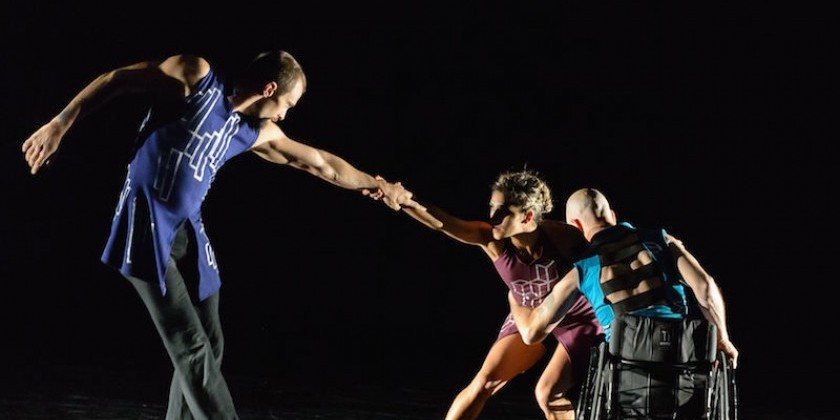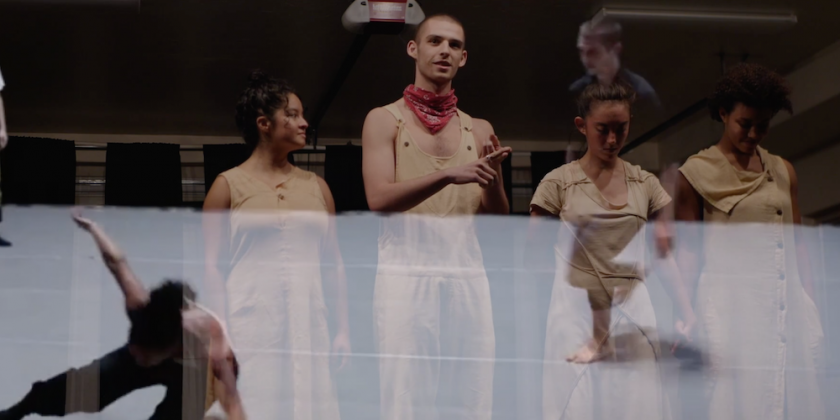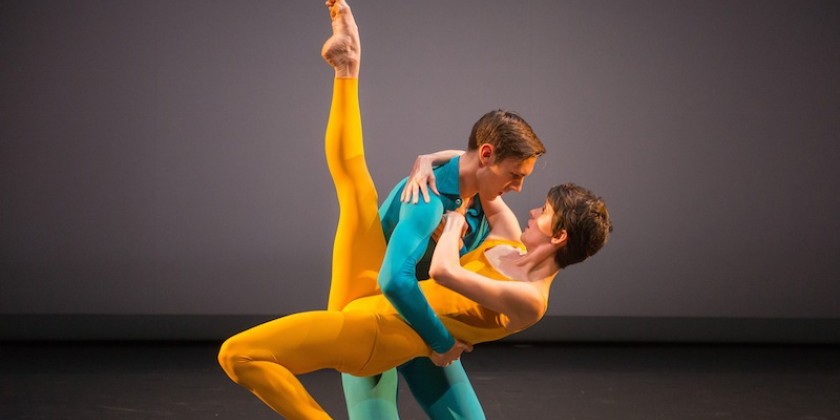IMPRESSIONS OF: Axis Dance Company and Heidi Latsky Dance

One Night Only at NYU Skirball Center for the Performing Arts
Presented by: NYU Skirball Center for the Performing Arts, November 15th, 2015.
Dancers: (AXIS) Brendan Barthel, Nick Brentley, Julie Crothers, Keon Saghari, Dwayne Scheuneman,
Sophie Stanley.
(Heidi Latsky Dance) Landes Dixon; Meredith Fages; Jerron Herman; Jillian Hollis; Heidi Latsky; Saki Masuda; Robert Simpson; Jubil Khan; Gregory Youdan, Jr.
Choreographers: (AXIS) Marc Brew—concept, direction, choreography in collaboration with the dancers for “Divide”; Joe Goode—concept, choreography, writing for “to go again”; (Heidi Latsky Dance) Heidi Latsky—in collaboration with the dancers for “Somewhere”
Music: (AXIS) Caroline Penwarden for “Divide,” Ben Juodvalkis for “to go again”; (Heidi Latsky Dance) Chris Brierley for “Solo 1,” Xi.Me.Na Borges for “Somewhere”
Costume Design: (AXIS) Keriann Egeland for “Divide,” Jenny Gonsalves for “to go again”; (Heidi Latsky Dance) Carlos Arias for “Solo 1,” Heidi Latsky and company for “Somewhere”
Lighting Design: (AXIS) Allen Willner for “Divide,” Jack Carpenter for “to go again”; (Heidi Latsky Dance) Robert Wierzel for “Solo 1” and “Somewhere.” Lighting Supervisor: Susan Hamburger for “Somewhere”
Dramaturg: (Heidi Latsky Dance) Stewart Schulman for “Somewhere”
On Display: A Movement Installation
Performers: In addition to several of the dancers listed above: Khaleah London, Samir Arboleda, Terrence Hewitt, Jacqueline Ledesma, Tiffany Geigel, Weasel Sawyer Eason, Bo Pressly, Judy Garfinkel, Nico Gonzales, Carmen Schoenster, Krishna Washburn, Gwendolyn Gussman, Leslie Freeman, Louisa Mann, Lawrence Goldhuber, Quemuel Arroyo, Carlo Rizzo, Maria Schirmer, Peter Trojic, Kimberly Olstad, Rahoel Hhandler, Rishma Dhanraj, Brenda Green Concept and choreography: Heidi Latsky Creative Consultants: Stan Harrison, Alissa Levin Films: Janet Wong Text: Jerron Herman, with additional text by Eve Mykytyn Fashion Design: Anna Kathleen Little Sound Design: Ximena Borges. Text Audio Execution: Lawrence Goldhuber
The next time your bus halts to accommodate a paying passenger in a wheelchair, and you groan to lose the minutes it takes for the driver to accomplish the various tasks necessary to make it possible for the passenger to ride safely, imagine a dance called the "Capitol Crawl." Here's how it's done: Become paralyzed or acquire cerebral palsy, or handicap yourself with one or even several of a vast variety of physical and/or mental conditions. Watch with increasing frustration and pain as legislation entitled the Americans with Disabilities Act — the most important civil rights legislation of the past quarter century — is deliberately delayed from passage by recalcitrant members of Congress. To dramatize what's at stake to the public at large, you and fellow demonstrators from 30 states somehow get yourselves to the bottom of the stone steps of the Capitol building in Washington, D.C., and then, without any assistance mechanical, animal, or human, conduct yourselves from the bottom of the steep stairs to the top. Talk about physical creativity! If you're eight-year-old Jennifer Keelan, you hoist yourself up using only your knees and elbows. Meanwhile, if you're 33-year-old Paulette Patterson, you lie down on the steps facing the sky and inch yourself backward up the stones. Whoops! Don't get stepped on by that U.S. Senator ambling down the stairs! What on earth could possess people to make such public spectacles of themselves? As Ms. Patterson put it to the Los Angeles Times: “I want my civil rights. I want to be treated as a human being.” The “Capital Crawl,” as the demonstration came to be termed in the press, embarrassed Congress and seems to have helped in making the Americans with Disabilities Act a law within months.

To celebrate that law's passage in 1990, the same year as the “Capital Crawl,” NYU's Skirball Center recently produced a singular evening, bringing together the 15-year-old, New York-based company of Heidi Latsky (who has fielded disabled dancers beside able-bodied ones in her own work for much of the past decade) and the 28-year-old AXIS Dance Company, based in Oakland, California, which “exists to change the face of dance and disability.” The program — part of Skirball's new, annual DANCE SPEAKS series, whose mission is to showcase dance that addresses “current issues that shape our lives and reflect our times”—was divided into three parts. For the hour preceding the dance performance, nearly 30 performers (some of them with physical disabilities), distributed on both the upstairs and lower auditorium-level lobbies of the facility, each person in a unique, stark-white outfit, played individual games of statues accompanied by films, electronic text, and sound scores. The intention was to call attention to the culture's obsession with body image. This was Ms Latsky's On Display, a version of a movement installation that has been seen elsewhere in New York and that will also be performed in the city next year. The second part of the evening — the dance performances proper — comprised two discrete works from AXIS and two linked works from Heidi Latsky's group. The third part of the evening consisted of a discussion and audience q+a with Ms. Latsky and AXIS artistic director, Judith Smith, moderated by Lane Harwell, executive director of Dance/NYC.
The set-up for On Display includes glamorous lighting, the charisma of tableaux vivants, and recordings of a man and a woman reciting clinical descriptions of the physiques and mannerisms of individuals. Just as you think the model for them is a medical chart — or, perhaps, an auctioneer's file — the entries are punctuated with luxurious phrases, appropriate to a fashion magazine. The installation is posterish, but it's also hard to tear oneself away from it.

In the theater, the performance led off with the AXIS company's Divide, by Australian choreographer Marc Brew, who, himself, was put into a wheelchair by a car crash when he was 20 but who persevered to build an international career as a dance maker. The program lists as dancers for Divide two men (Brendan Barthel and the wheelchair virtuoso Dwayne Scheuneman) and one woman (Keon Saghari), but my recall is that the work included Julie Crothers as well, so I'm a little confused about the full identity of what I saw. (Ms Crothers, a dancer with a lovely figure and resilient movement, lacks part of one arm.) The choreographic configurations showcased acrobatics, Mr. Scheuneman's bravura partnering and wheelie skills, and geometric formations in the cast's floor patterns and architectural couplings. A program note explains that the choreography was inspired by the controversial minimalist art of sculptor Carl Andre (b. 1935, retired from practicing art since 2010), although, to my eye, the inspiration was subtle to the point of invisibility. AXIS also closed the performance with to go again, a dance-and-text work about returning wounded veterans of the Iraq and Afghani wars, conceived and sketchily choreographed by Californian Joe Goode, who also wrote the emotionally wrenching script.

In the middle of these came Latsky's Solo 1 for herself — a gradually windmilling torrent of energy for the upper body, unleashed mostly while the dancer keeps her feet planted in one spot — which bled into her Somewhere, for nine dancers, who execute with conviction the polyrhythms and various rotations of their choreography. As performance, Solo 1 was in a different league from the rest of the program. Ms Latsky, a memorable former dancer in the company of Bill T. Jones, can still command the stage.
Unfortunately, the hanging theatrical lights for these works, which did give the lovely effect of constellations in the night sky, required some 20 minutes of preparation and then of rewrapping, in full view of the audience, thereby stretching out the evening's running time from 1 hour 40 minutes to over two hours. The patience required of the audience exemplifies the demands on an artistic and/or entertainment enterprise that seeks to stimulate a particular viewpoint concerning extra-theatrical issues. Less than half the audience remained for the moderated talkback, and so those who fled missed Smith's weary earnestness (“In 1997 AXIS imploded: too much work about disability; we could say more about ability”) and Latsky's amusing cynicism. (She spoke of the “angle” she thought working with disabled performers would give her in applying for grants and her surprise that “the money for disability is for research, not for the arts.”) That is, they missed the reality of trying to integrate disability into theatrical dance over the long haul. Listening to Latsky and Smith (who is also in a wheelchair), I certainly admired them but I also understood why this program was one night only.
Share Your Audience Review. Your Words Are Valuable to Dance.
Are you going to see this show, or have you seen it? Share "your" review here on The Dance Enthusiast. Your words are valuable. They help artists, educate audiences, and support the dance field in general. There is no need to be a professional critic. Just click through to our Audience Review Section and you will have the option to write free-form, or answer our helpful Enthusiast Review Questionnaire, or if you feel creative, even write a haiku review. So join the conversation.












